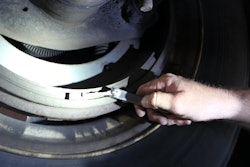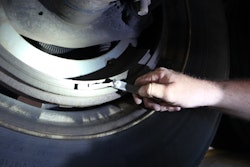
By John Smith
It is said timing is everything, and the injection of fuel has always been a matter of timing. Add the proper amount of atomized diesel into a cylinder at just the right moment, and the engine responds with the cleanest burn and the best performance. This explains why engineers have been investing so much of their time on systems that deliver well-timed shots of fuel at extremely high pressures. The injection process has certainly come a long way.
The performance of traditional pump line nozzle systems was always directly dependent on the speed of the engine. At 0 rpm, the engine did not generate the pressure for an injection of fuel. Conversely, the top forces were only created at the top engine speed.
If the two points were plotted on a graph, there would be a straight line between the two, notes Tim Shick, director of business and product strategy for Navistar’s engine group. At lower engine speeds, it meant that the fuel was more likely to be delivered in the form of a slug of diesel rather than a fine mist, generating the puff of smoke that would spill from the stacks.
Enter electronic unit injectors that could deliver higher pressures across a wider range of operating speeds, regardless of whether the truck was accelerating or lugging. Those higher pressures are more important than ever before.
“The solution to meeting EPA ’10 [2010] emissions with good fuel economy is all about a high pressure fuel injection system and its ability to atomize the fuel. In general, the higher the injection pressure, the finer the atomization and the greater the fuel economy,” explains Ed Saxman, product manager, drivetrain, with Volvo Trucks North America. “High-pressure fuel injection minimizes the soot… low soot formation means that 100 percent of the soot can be regenerated from the [diesel particulate filter] passively, without the use of additional fuel.”
To suggest that modern injection systems are dealing with historically high pressures would be an understatement. The 35,000 psi pressures that are generated for today’s Volvo engines are 20 percent higher than the 29,000 psi that was generated for the engines built between 2002 and 2006. Cummins is generating similar pressures, through the XPI fuel system that was produced for big-bore, on-highway engines in a partnership with Scania.
But manufacturers have taken two distinctly different approaches to modern fuel systems, either refining existing electronic unit injectors, or adopting common rail systems that pressurize a supply of fuel within the rail that feeds the injectors. Rather than generating pressure with the barrel and plunger on a unit injector, a common rail system includes a high-pressure pipe and piston pump that has enough capacity to maintain pressures at lower engine RPMs.
There are some differences in the systems, of course. Detroit Diesel’s Amplified Common Rail System (ACRS) generates 50 percent of its injection pressures with a high-pressure pump, and amplifies that pressure at the injector itself. The idea here is to limit the stress on the fuel lines and pump, as well as offering more precise control at the nozzle.
Common rail systems deliver injection pressures that are “infinitely variable and totally programmable. You can do anything you want with the fuel system,” Shick says, noting how Navistar is using its approach to generate less NOx within the cylinder.
The peak pressures are not that different than those generated by an electronic unit injector. But the nozzles will open and close within 0.4 milliseconds, offering five injections per combustion event, notes Gene Gollub, a supervisor in Denso’s technical services department.
“Even those two [extra] injections per combustion event help with the cleanliness,” he says.
Each injection event performs a slightly different role. In the case of the five injections, the “pilot” injection allows the fuel and air to mix before injection. That is followed by the “pre” injection that helps to shorten the delay of ignition during the “main” injection that follows – reducing NOx, noise and vibrations in the process. The “after” injection re-burns particulate matter that may remain, and the “post” injection helps to manage the temperature of exhaust gases, making exhaust gas rwecirculation [EGR] systems more effective.
The systems also use different technologies to control the actual injection, adds ProDiesel vice president of production, Joe Hutto, referring to solenoids, electromagnetic force and ceramic-based Piezo technology, which is three times as fast as its counterparts.
CLEAN FUEL IS VITAL
One of the key preventive maintenance strategies for any of these fuel injection systems involves the related filtration of fuel, since the higher pressures also can deliver the tiny abrasive particles that can braise poppets and valves.
“The orifices and the tolerances all inside the pump and the injector are much tighter,” Gollub explains. “For the common rail system, any little particle larger than, say, .25 mm in size or something like that, can cause problems.”
The related damage can manifest itself in a number of ways. When fuel first begins to run back into the tank, there will be a marginal affect on the engine’s fuel economy. “The first thing you see is you’re a couple of tenths off on [mpg],” Shick says. As the situation worsens, the electronic fault codes begin to emerge, complete with a loss of power that can occur under extreme situations.
It all makes the condition of fuel filters more important than ever. Service technicians should be watching over all levels of filtration, such as the units that filter out water and the largest debris (Shick calls these “rock catchers”), and the engine-mounted filters that catch the finer material.
Clogged fuel filters or a bad fuel pump in the low-pressure rail that circulates fuel to the unit injectors can present a number of challenges, Gollub agrees. “It’s going to be misfires, it’s going to be rough idle, surges, lack of power, lagging, stumbling, hard start, no start… you’re going to have your early indicators.”
High injection pressures also can present other maintenance challenges. Saxman, for example, refers to issues such as cracked alternator mountings or cracked EGR coolers that can emerge.
“Those problems arise from ‘torsional vibrations,’ or high-frequency pulsing that originates with the fuel-injection system,” he says, noting how Volvo has addressed the issue with camshaft-mounted vibration dampers that have been used since the D12C was introduced in 1998.
“Another way torsionals can be reduced is to drive the camshaft from the rear. This focuses any remaining torsional vibrations into the flywheel, which is the rotating part of the engine with the greatest mass,” Saxman adds.
VALVE REPLACEMENTS MADE EASY
But what about the valves themselves? Where are they likely to fail?
Hutto suggests the failures normally will occur in the controlling area of the valve, such as the poppit valve on a Detroit Diesel Series 60 engine. Common rail systems, meanwhile, will tend to wear out at the nozzle and check valves.
Luckily for service technicians, one of the advantages of a common rail system comes in the form of easy injector replacements. These designs mean that there is no need to set unit injectors when running the overheads, and the need to repair highly stressed injector rockers also disappears.
Still, there are some important replacement procedures to follow with any style of injector. A number of the components cannot be re-used, even if they do seem “good enough” to fit. Seals, for example, sacrifice themselves when they are first installed.
Shick also stresses that technicians need to trust the diagnostic codes when deciding which injectors to replace.
“It’s amazing how many electronic components are returned fault-free,” he says, noting how technicians who find a fault code with one injector often decide that the rest should be replaced at the same time. “Don’t try to rationalize around the system. Don’t jump to the conclusions it’s a wear issue… with all good intentions, they [technicians] think they’re saving customer callbacks and saving themselves headaches. In the end, that causes a lot of excess expense.”
“When using the scan tool to diagnose the vehicle, you still have to apply what you learn from your scan tool to your troubleshooting process,” Gollub adds. It means that technicians must remember to search for the root cause of a problem when injectors are being replaced. “Start fishing back into the system,” he says, referring to the filters, filler neck, fuel tank and water separator.
It is a good habit to adopt, considering that the filtration will become more important than ever in the years to come.
Hutto, for example, suggests that the industry is nowhere near the limit of the pressures that will be introduced.
“I’ve heard talk of 150,000 [psi],” he says.
Engineers are obviously under some extra pressure to create the components that will support the additional forces.








